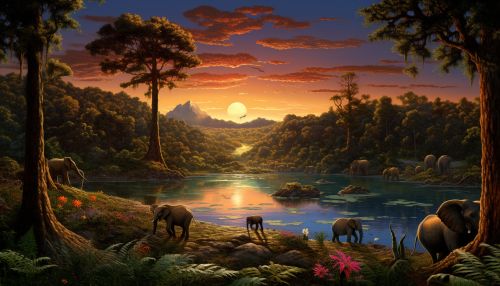Oligocene
Introduction
The Oligocene epoch, a significant period in the geologic time scale, lasted from about 33.9 million to 23 million years ago. This epoch, nestled between the Eocene and Miocene epochs, is part of the Paleogene Period within the Cenozoic Era. The Oligocene epoch is noteworthy for several major global changes in the planet's climate, geography, and biodiversity.
Etymology and History
The term "Oligocene" derives from the Greek words oligos (meaning "few") and kainos (meaning "new"), signifying the fewer number of modern animal forms that emerged during this epoch compared to the preceding Eocene epoch. The epoch was first named by the German palaeontologist Heinrich Beyrich in 1854.
Climate
The Oligocene epoch was a time of significant climatic change, marked by a global cooling trend that likely led to the formation of the first permanent ice caps in the Antarctic. This cooling trend was a continuation from the late Eocene epoch and was likely driven by the decrease in atmospheric carbon dioxide levels. The cooling of the global climate during the Oligocene epoch had a profound effect on the planet's ecosystems and led to a major shift in the flora and fauna.
Geography
During the Oligocene epoch, the continents continued to drift towards their current positions. The formation of the Isthmus of Panama led to the isolation of the Atlantic and Pacific Oceans. This geographical change had a significant impact on ocean currents, climate, and marine life. The formation of the Alps, the Himalayas, and other mountain ranges also occurred during this epoch, significantly altering global wind patterns and leading to further climate change.
Flora
The global cooling during the Oligocene epoch led to a shift in vegetation, with the expansion of grasslands and the decline of tropical rainforests. The development of grasslands played a crucial role in the evolution of large grazing mammals. The Oligocene epoch also saw the first appearance of many modern families of flowering plants.
Fauna
The Oligocene epoch was a time of significant change in the Earth's fauna. The cooling climate and the expansion of grasslands led to the evolution of new types of herbivorous mammals, such as horses and rhinoceroses. The epoch also saw the emergence of the first carnivorous mammals, including the ancestors of modern cats, dogs, and bears. The Oligocene epoch also witnessed the decline of archaic mammal groups like the brontotheres and the entelodonts.
Oligocene Extinction
The end of the Oligocene epoch was marked by a minor extinction event, known as the Oligocene extinction. This extinction event, which occurred approximately 23 million years ago, led to the disappearance of several marine and terrestrial species. The causes of the Oligocene extinction are still under investigation, but it is believed that rapid climate change and the impact of an asteroid or comet may have played a role.
Conclusion
The Oligocene epoch was a time of significant change on Earth, marked by major shifts in climate, geography, and biodiversity. The cooling of the planet led to the formation of the first permanent ice caps and the expansion of grasslands, which in turn drove the evolution of new types of mammals. The epoch ended with a minor extinction event, which paved the way for the subsequent Miocene epoch.
See Also


